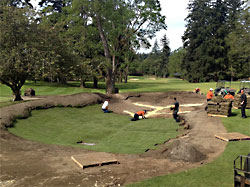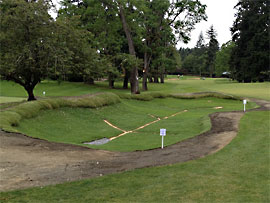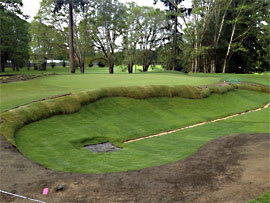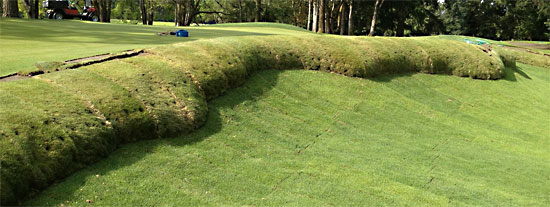|
Bunkers look'n good...
Joel Kachmarek, Tacoma Country and Golf Club, Lakewood, WA:
  "The first load of sod came in this past Tuesday and I think that afternoon we almost hit 80 degrees. Not ideal conditions for laying sod. Not only did the heat put a lot of fatigue on the guys, it also put a lot of stress on the sod and I really thought I was going to lose some of it. The crew knew this stuff had to get off the pallets and many of them put in 12 hours that day to get the job done. I honestly have the best crew ever. They did get the job done, we got the water on it, and I'm happy to say we didn't lose any sod.
"Once the sod on the floor is established and rooted in, it will be sprayed out and the bunker sand will be installed..." |
The first thing finished was sodding of the bunker floor. Once the sod on the floor is established and rooted in, it will be sprayed out and the bunker sand will be installed. The sod decomposes under the sand and becomes an impermeable layer which protects the bunker sand from being contaminated by rocks or native soil within the bunker floor. There are many fabrics or other materials being used in the industry to line the floors of bunkers. Simply put, at 28 cents/sq ft. (delivered), nothing comes close to the affordability of sod.

|
 |
Above left is the same bunker today. You can see we have cut the sod off the drain lines so there will be rapid infiltration over the drain pipe.
Above right is the bunker to the right of #6 green. It really turned out beautiful. Although the grass on the floor looks similar to the grass on the bunker lip, it isn't the same at all. The grass on the floor is straight perennial ryegrass. The grass on the robust lips is fine fescue and it will be kept at a higher mowing height than the surrounding turf which will add a dynamic, classical, rugged look.
Below is a close up of the robust bunker lip which architect John Harbottle III refers to as a "bull-nose" style. I simply love this look and I'll give props again to John and the guys from Ridgetop Inc. for their excellent craftsmanship.

Next Tuesday the remainder of the sod will be laid and then its just waiting till there is good enough rooting to kill the stuff and put the sand in. I'm guessing that they will be done for U.S. Open Field Day on June 9th. These bunkers are going to be so cool."
Visit Joel's blog at tacomaturf.com.
|